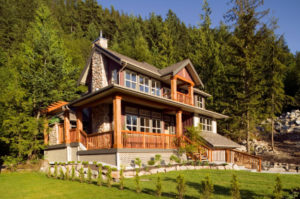Timber frame homes have a long history that can be seen in medieval and Tudor buildings throughout Europe. They eliminate the need for the typical studs in house framing and allows builders to fill in the gaps with a variety of materials. Today this same timeless design can be as energy efficient as it is beautiful and it lends itself to passive solar building techniques. 
Passive solar does not mean that you have to install solar panels and produce electricity. Passive solar homes use interior and exterior design to maximize winter heating, summer cooling and daily light. A well designed home can save more money by increasing heating and lighting efficiency than by using solar panels, although solar panels can further decrease a homeowner’s the reliance on the local energy grid.
The wide spaces between the beams of a timber frame home can fit a wide variety of insulating materials. Straw bale and found materials are fun and easy to find possibilities, but more energy efficient insulations are possible such as SIP’s. The beam spacing also allows builders to design in the all important south facing windows which form the aperture to let in sunlight during the cold part of the year. Basic timber frame home design already uses an open floor plan, which allows heat and light to reach every part of the house.
In a passive solar timber frame home, the flooring material helps absorb and radiate or conduct heat energy gathered by the aperture window. The top layer, near the aperture, should be dark in color to absorb as much heat as possible. Below the top later of flooring is the thermal mass. This flooring layer can be stone, concrete or another material that will conduct the absorbed heat.
Timber frame homes are gaining popularity in the US. They are easy to design and build and even easier to include design features to fit modern, energy efficient demands. These features do not add very much to the cost because they take the place of other materials. Simple attention to the orientation of the house and choice of window placement makes an enormous difference. Floor plan and materials that allow absorption and heat exchange in a completely passive way reduce the home’s carbon footprint.